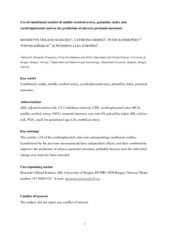Use of conditional centiles of middle cerebral artery pulsatility index and cerebroplacental ratio in the prediction of adverse perinatal outcomes
Journal article
Submitted version
Permanent lenke
https://hdl.handle.net/1956/12680Utgivelsesdato
2016-06Metadata
Vis full innførselSamlinger
Originalversjon
https://doi.org/10.1111/aogs.12912Sammendrag
Introduction. Centiles of middle cerebral artery pulsatility index and cerebroplacental ratio are useful for predicting adverse perinatal outcomes. A ‘conditional centile’ is conditioned by a previous measurement reflecting degree of individual change over time. Here we test whether such centiles are independent predictors and whether their combination improves prediction. Material and methods. This prospective longitudinal study included 220 pregnant women diagnosed with or at risk of having a small-for-gestational-age fetus. Serial Doppler measurements of the umbilical artery and middle cerebral artery pulsatility indexs were used to calculate cerebroplacental ratio. Preterm birth, operative delivery due to fetal distress, admission to neonatal intensive care unit, 5-min Apgar score <7, newborn hypoglycemia, and perinatal mortality were considered adverse outcomes. Possible associations were analyzed by logbinomial regression analysis. Results. Serial Doppler measurements of the middle cerebral artery were available in 207 participants and cerebroplacental ratio in 205. Conditional centiles ≤5 and ≤10 for both middle cerebral artery pulsatility index and cerebroplacental ratio were associated with increased risk for adverse perinatal outcomes. However, only the combination of cerebroplacental ratio centile and conditional centile ≤10 showed a better performance in the prediction of operative delivery due to fetal distress (p = 0.032), admission to neonatal intensive care unit (p = 0.048), and the combined variable “any adverse outcomes” (p = 0.034) compared with the use of centile ≤10 alone. Conclusions. Conditional centile for middle cerebral artery pulsatility index and cerebroplacental ratio ≤5 and ≤10 are associated with adverse perinatal outcomes. When adding conditional centile to conventional centile for cerebroplacental ratio, the prediction improved compared with the use of conventional centile alone.
